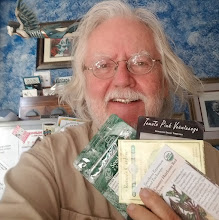
It's not enough to grow the stuff, you also got to decide what to do with it! Six pounds of Sweet Banana Peppers and what to do? I think I can make some decent pepperoncinis with them - just need to find a recipe.
At this time, a gardener also needs to keep the green and yellow beans picked (they can be pickled as well) or they’ll stop producing. Keep using the basil, continually pinch their tips – flowers and the first pair of leaves and throw into whatever you're cooking or a salad - the flowers are as edible as the leaves. Next month, you can harvest whole plants and make pesto and this constant pinching will cause the plant to grow into a vigorous small shrub! Share the abundance of all your produce with friends, relatives or a food bank. Nature isn’t stingy so carry on that tradition and share too. We all need a fresh homegrown tomato now and then to remind us how blessed we really are.
Anything planted into the garden in August is an act of desperation. Mind you, you CAN plant, but it isn't going to be a cakewalk for you or the plants. You'll both need extra water and you both will chance a sunstroke that could kill them much more readily than you. You, at least, should have the sense to move into the shade if you notice symptoms of hyperthermia. Plants, on the other hand, have to stay put. If you do plant on a hot day, it is not a bad idea to find someway to shade your little darlings. A stick propping up a black nursery flat, with the flat covering from the south of the plants is a tried and true way for many gardeners to provide shade for their newly planted starts.
What to plant in the coming months is a great game gardeners play, wiling away long, insufferably hot hours in the shade. It is best to write down some of the ideas you're having for next summer's garden now. while this year's experience is fresh, otherwise the harvest of knowledge could be wasted. Of all the ways to learn gardening, the most sure and least expensive is to keep a garden journal. It is so easy now days and can be very inexpensive. If you have a computer, a digital camera and a word processing program you are set up. It can be a cheap camera (find a used one on eBay) and a free word processing program (I'm using Open Office Writer to do all my writing nowadays), and your thoughts will be preserved for the next year's garden. If that's not your bag, get a paper notebook, draw your plans, paste in pictures from catalogs and write your observations in a multitude of colors. Or use a combination! The point is to write down things so you'll remember them and to find a way to write them down that will give you enough pleasure to insure you'll do it. A chair or bench in your garden is the most perfect place to do this. Haul out a few catalogs, something cool to drink, sit down in the shade with your notebook (computer or paper) and think about the year gone by. It can be a meditation that is almost as good as eating from your garden. See below for a few catalogs to consult in preparing your next garden.
But don't throw all your attention in to next summer's garden. Spend some time now to consider what you will grow in our mild winters. I'm looking through some catalogs looking for cabbage, broccoli, onion, lettuce and other seeds. If I order them soon, I'll have them by the end of August and I'll be starting little pots of seedlings that will be going out into my garden by the beginning of October. Below, I've listed a few of the vegetables I want to grow along with some varieties that I like. I'll order seeds to start now, and, to save on postage, I'll order seeds that I'll be using a little later on.
However, no matter the state of the present, August is the time to contemplate the fall and winter garden; I’m in my seed catalogs already dreaming of my next great adventure in the garden. Soon, in sheltered locations, I’ll be starting seeds of broccoli, cabbage, kale, leeks and onions. I’ll plant several different heirloom varieties of sweet peas – maybe some blends of antique varieties, two seeds per pot. I’ll pour very hot water over the seeds the night before and leave them to soak until I actually stick them in their pots. It is amazing to see how much they have swollen from absorbing water because of that treatment. Don’t worry, pouring even close to boiling water on them won’t kill these seeds because the seed coat is too hard and the hot water will help the seed inside to break free.
david






.jpg)
No comments:
Post a Comment